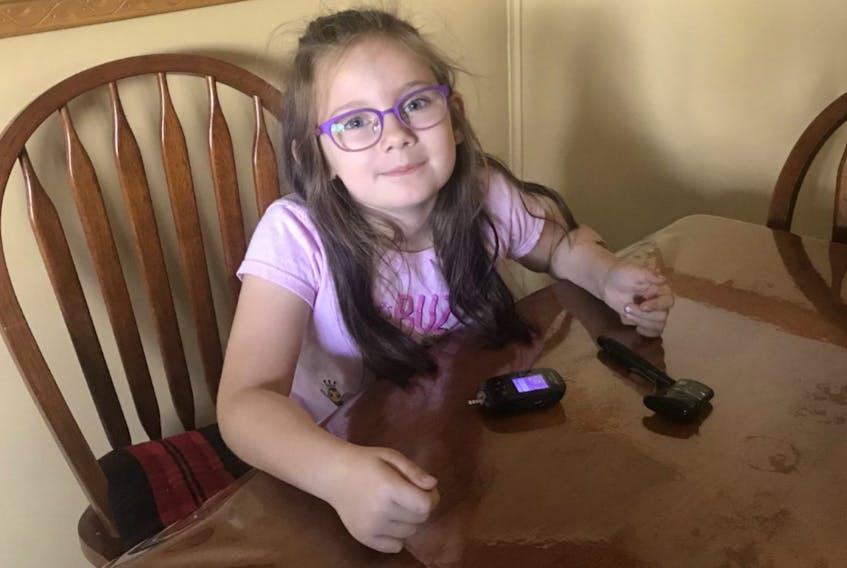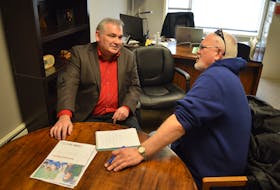ST. JOHN'S, N.L. — In the summer of 2018, when Cindy Greenslade noticed her five-year-old daughter, Madison, couldn’t get enough water, she assumed it was simply a sore throat.
But after bringing her to their family doctor, it was suggested she get checked for diabetes.
“She checked her sugars and the meter read high,” Greenslade said. “She sent us straight out to the Janeway.”
They spent four days in the Janeway and their routine hasn’t been the same since that day.
“(The learning curve) was really big,” Greenslade says.
“It’s been a struggle. Every day is different.”
They get up and check Madison’s blood sugars. What those are will determine the amount of insulin Madison needs and what she has for breakfast. Then they get ready for school.
In school, Madison has her blood sugars checked at 10 a.m., after recess, before lunch, after lunch and after school.
“It’s been a struggle. Every day is different.” — Cindy Greenslade
She gets a snack and has playtime. They check her blood sugars before and after supper. They’ll count the amount of carbohydrates in their supper, subtracting the amount of fibre and, depending on that, adjust the amount of insulin she will need.
Failing to monitor and adjust for her insulin levels could potentially put Madison in a coma, or worse.
Greenslade says, at this point, trying to make her daughter understand it’s OK to have diabetes can be difficult. Madison often says she wishes her life was different and that she didn’t have diabetes, Greenslade says.
And Madison’s life would be different with a diabetic alert dog. She would still have to monitor her sugars — that’s not going away. But a dog would alert any adult around her if her blood sugars were getting to a dangerous level, either high or low.
This is something Rhea Dale knows well.

Dale’s son, Nathaniel, was diagnosed with diabetes at age three. Much like Greenslade, Dale says she had no idea about the amount of work it required to keep someone’s blood sugars at a stable level.
“No one really knows until you live it,” Dale said.
“It takes minute-by-minute management.”
When they were in the hospital, one of Dale's friends visited and mentioned someone they knew who had a diabetic alert dog.
“I had never heard of a dog that could smell blood sugar,” she said. “But it didn’t surprise me because dogs are amazing.”
After some research, she began fundraising for a dog for her son. But adding this to the list of day-to-day requirements of raising a three-year-old, let alone a child recently diagnosed with diabetes, was actually a good experience, she said.
“I was able to put some positive energy into fundraising for the dog,” she said.
“I guess you could call it cathartic, or therapeutic for me emotionally and for my son, because we were given videos of the dog and we followed her progress and her training.”
In order for the dog to be trained, Dale and her husband would have to take a cotton swab when Nathaniel’s blood sugars were within a certain range and put it in his mouth to collect saliva.
“I guess you could call it cathartic, or therapeutic for me emotionally and for my son, because we were given videos of the dog and we followed her progress and her training.” — Rhea Dale
Those swabs would be put in a jar, frozen and sent to Las Vegas, where the dog was being trained. From those swabs, the dog would be taught to alert an adult if blood sugars were too high or too low.
Having Skipper, Nathaniel’s diabetic alert dog, doesn’t take away from the amount of times his blood sugars have to be checked throughout the day. What Skipper does provide, aside from companionship, is a sense of security.
While many times throughout the day blood sugars can be, to a certain degree, predictably managed, it’s those other unexpected highs and lows, which can come out of nowhere, that can cause lasting negative effects.
“(These dogs) can save a life, that’s what they do,” Dale says.
“If he goes outside after lunch, that can affect his blood sugar after supper. Cold weather affects blood sugar. Everything affects blood sugar. The dog saves him from those scary numbers.”
Dale says Skipper has saved Nathaniel from feeling the effects of countless low blood sugars.
“My husband and I joke and say, ‘Well, she pays for herself today.’”
That’s a tall feat, considering diabetic service dogs can cost anywhere from $8,000 to $20,000, which is why Greenslade has set up a GoFundMe account, is doing bottle drives and selling gift baskets. The Green Depot also has an account set up for Madison, where people can drop off recyclables on her behalf.
“It would give Madison more independence,” Greenslade said.
“It would give us peace of mind, too, knowing that these lows and highs that are so dangerous would be prevented.”
Twitter: @andrewlwaterman
WANT TO HELP?
RELATED
- Stu Cowan: Canadiens' Max Domi chronicles life as a diabetic in new book
- Canadiens impressed with how Max Domi handles his Type 1 diabetes
- Wounded Warriors Canada PTSD service dog program launched
- Prince Edward Islander’s former service dog honoured for service with U.S. army
MORE FROM ANDREW WATERMAN









